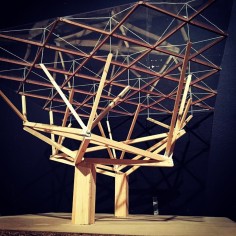Arata Isozaki
أراتا إيسوزاكي
이소자키 아라타
矶崎新
АРАТА ИСОДЗАКИ
Arbre

source: impactodesignblogspotes
Caixa Forum se alberga en un edificio del modernismo catalán, es una fábrica construida totalmente en ladrillo visto.
Para la restauración del edificio colaboraron los arquitectos Arata Isozaki con los “Arboles gemelos”, una cubierta en la entrada del edifico de cristal sobre una estructura.
.
.
.
.
.
.
.
source: obrasociallacaixaes
The Japanese architect Arata Isozaki designed the main entrance and the visitors’ reception area in the Centre.
Access to CaixaForum is by way of a sculpted structure in the form of metal trees covered by panes of glass. This is a full-blown work of art, combining a sensation of lightness with a hint of the oriental, all intended to welcome the visitor to CaixaForum. The escalators and the lift run from Isozaki’s sculpture down to the open-air English courtyard below, which gives onto the foyer.
This part of the building also houses the “Secret garden”, a minimalist, intimate, closed-off dwelling.
Casimir Casaramona i Puigcercós (Vic 1838 – Barcelona 1913) commissioned the famous architect Josep Puig i Cadafalch (Mataró 1867 – Barcelona 1956) to design a factory for his textile-production enterprise. In addition to being a widely acknowledged architect whose works included the Amatller, Macaya, Quadras and Terradas houses, Puig i Cadafalch also played a leading role in the art-nouveau movement alongside Gaudí and Domènech i Montaner.
Puig i Cadafalch completed the Casaramona factory in 1911, culminating his art-nouveau period with it. The building features the simplicity and clarity of the thoroughly worked-out masterpiece: its bare brickwork is topped by Catalan vaults resting on castiron columns and enclosing light-filled, spacious workshops. Its response to the triumph of the horizontal that was characteristic of the local Gothic style is presented through the rhythm of its battlements on the one hand, but also and more particularly through the bold aspect conferred on the building by its two slender towers. It was awarded the City Council’s prize for the best industrial building in that same year.
The Casaramona factory was closed down just seven years after its opening. After that, it was pressed into service as a warehouse during the Barcelona World Fair of 1929, and in 1940 it was converted into stables and garages for the National Police Force. “la Caixa” acquired the building in 1963, and in 1992 it was decided to return this building of great artistic value to Barcelona and to the country as a whole, while lending it a new function with social, cultural and educational aims, it thus becoming CaixaForum.
The architects Arata Isozaki, Francisco Javier Asarta, Roberto Luna and Robert Brufau all played their part in the refurbishment and extension work.
.
.
.
.
.
.
.
source: barcelonapaginanl
Het CaixaForum is een kunstgalerij in Barcelona. Het wordt gesponsord door de Barcelonese bank “la Caixa”, en opende in 2002 in een voormalige fabriek. CaixaForum is gelegen op de Montjuïc. Het museum herbergt momenteel (tijdelijke) exposities. Het gebouw werd oorspronkelijk gebouwd in opdracht als een textielfabriek van Casimir Casaramona i Puigcercós, en gebouwd door de beroemde Catalaanse architect Josep Puig i Cadafalch. De fabriek werd in 1911 voltooid. Het sloot in 1918, maar heropend als een magazijn in 1929. In 1940 werd het gebouw gebruikt door de Spaanse nationale politie, en het werd gebruikt als zodanig tot “la Caixa” kocht het in 1963. Het werd geopend als museum in februari 2002. Het gebouw werd gerestaureerd voorafgaand aan de opening, en een nieuwe entree werd gebouwd, ontworpen door de Japanse architect Arata Isozaki. Het museum, dat in het voorjaar van 2002 is geopend, heeft bijna drie hectare tentoonstellingsruimte, een mediatheek, een auditorium, klaslokalen en een restaurant. Bezoekers dalen door roltrap naar de kelderruimte, versierd met een Sol LeWitt muurschildering, waarna men vervolgens weer stijgt naar de tentoonstellingsruimtes op de begane grond.

